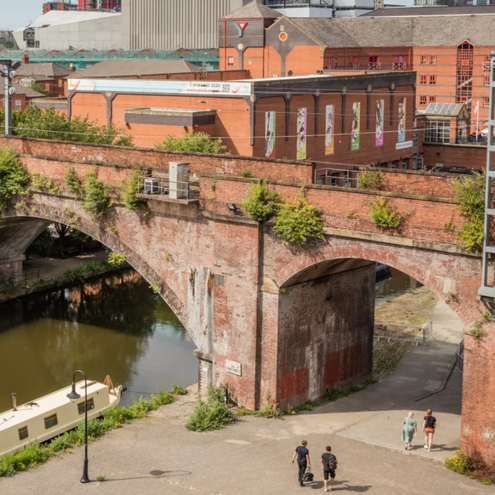Project showcase
Castlefield Viaduct, Manchester – National Trust & National Highways with Twelve Architects

An urban park in the sky, this striking Victorian-era steel viaduct in the heart of historic Manchester has been transformed into an accessible green space. The grade II-listed Castlefield Viaduct was once used to transport goods in and out of Manchester but it has remained idle since the city’s central station closed in 1969.
Project developer/ client: National Trust & National Highways
Who is on the project team? : National Trust, Castlefield Forum, Arup, Twelve Architects, Royal Haskoningdhv, Stace, Purcell, National Highways, Historic Railway Estate, Manchester & Cheshire Construction
Describe the context of this project and the point it has reached in its development. When is the project expected to complete?
Castlefield Viaduct is in Manchester city centre in the oldest part of the city that boasts Manchester’s Roman origins, the first passenger railway in the world, and was the terminus of the Bridgewater Canal, the world’s first industrial canal.
The Viaduct was built in 1876 and designed by the same engineers who worked on the Blackpool Tower. Three tracks once ran across the viaduct, carrying heavy rail traffic, goods, and passengers to Central Station.
Predominantly steel, the structure is 330m long, comprising eight spans. Behind decorative castellations, bearing plates support the heavy end posts of 16 trusses. It is Grade II listed.
Following the closure of Central Station in 1969, the viaduct fell into disuse and the tracks were later dismantled. The viaduct has been left derelict ever since, with vegetation occasionally cleared by contractors to prevent structural damage.
Working with the community and partners National Trust has a vision to reimagine Castlefield Viaduct as an iconic urban park destination providing nature and greenspace amenity for the local community and attracting visitors from further afield, all whilst respecting the heritage fabric of the listed structure.
We’ve adopted a phased approach to delivery. The free to enter Phase One opened to the public in July 2022 – a temporary park and event space www.nationaltrust.org.uk/visit/cheshire-greater-manchester/castlefield-viaduct.
The purpose of Phase One is to gain feedback to shape future phases, generate momentum and provide users with a moment of joy. Work is underway to shape the next phase. The pilot will run until 2024.
How are you seeking to foster community, welcome visitors and attract tenants? How are you responding to changing demographics, behaviour, market context, policy, transport habits and the climate crisis since winning planning?
Community is at the heart of the project. We’ve been working with a broad range of community partners. There is a community representative on the Project Board ensuring the voices of local people shape the project. The event space is a hub for visitor feedback where views are collected to shape future phases of the project, including a visitor survey and ideas wall.
Phase One includes ‘partner plots’ - areas on the viaduct deck in which the National Trust invites local community groups and partners to activate the space. Groups include City of Trees, Castlefield Forum, Urban Wilderness, 42nd Street and the Science and Industry Museum.
The project employs an Experience & Visitor Programming Manager and a Community and Volunteer Manager. They have developed and implemented an inclusive programme of activity on and off the viaduct. Over 30 volunteers regularly engage and support the pilot. There is an active Instagram page.
Programming has focussed on targeting specific groups to ensure the project benefits a diverse range of people represented in the city. This has ranged from offering special days for Manchester carers and working with the sex worker community to hosting art, media and cultural events in the central building space and inviting young people to run their own events.
Inclusive design has shaped the pilot and it is free to enter. The viaduct is accessible by public transport, cycling and walking. A broad, flat DDA compliant path provides access to the length of the temporary park and onsite guides.
What is your sustainability strategy and how are you mitigating carbon use and construction pollution?
The Viaduct is in a highly accessible location and can be accessed by walking, cycling and public transport minimising the carbon impact of visitor travel and supporting affordability of access.
For the pilot construction, minimal capital materials were used with a focus on letting the structure be the star of the show. Over 80% of on-site materials are designed to be re-used or repurposed – including the central event space, which is a demountable, modular design. The event space incorporates energy efficiency design elements. The re-purposing of the viaduct is also re-using thousands of tonnes of embodied carbon used to build the viaduct in the C19th century.
There is a rainwater harvesting system to help with irrigation of plants. Plants were chosen based on their hardy nature and a peat free substrate was used for growing and planting.
During construction environmental considerations were implemented, including recycling of building waste, monitoring of run off to local watercourses to ensure construction did not result in pollution and noise regulations were adhered to.
A phase one ecology survey was conducted prior to construction. Bird boxes have been installed. New species have been noted since planting, including house sparrows and a sparrowhawk.
There is a data corner in the events space which provides real time environmental information, including onsite temperature and air quality readings.
Describe the social impact of the project: How is this place contributing to the economic, environmental and social wellbeing of its citizens?
Community partnerships and community engagement is at the heart of the phase one project. Two posts are dedicated to engaging volunteers, developing and delivering inclusive programming on and off site, and reaching a broad range of groups representative of the diversity of the city. The event space is regularly used for community events, and this will continue and expand during 2023-24.
There are four ‘partner plots’ on site where external organisations and partners are invited to activate a section of the viaduct deck for a minimum of six months. All four plots have been in use since the pilot opened in July 2022. Two new partners are being installed to welcome visitors in February 2024. The partner plots ensure the space is activated by and responds to a diverse range of audiences.
The project economically supports the local area encouraging new visitors into the area that use local cafes and bars. The project has gained international recognition and has been included in Manchester’s entry of best destination to visit in 2023 by National Geographic and Lonely Planet.
The viaduct also now provides a relatively quiet place of greenspace and nature in which visitors can escape busy city life to grab a few moments of natural joy.
The event space is used for many community events and a full 2023 programme has been developed with key partners.
Visitor and non-visitor opinions are proactively captured to shape the next phase of the project, that will be bigger in scope and impact.
Festival of Pineapples
24-26 February 2026
Pineapples prize giving night
April
Pineapples at Festival of Place
10 June 2026
© The Pineapples - Tweak Ltd. 124 City Road, London, EC1V 2NX. Tel: 020 3326 7238




